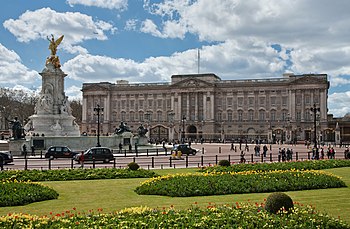Buckingham Palace
. Buckingham Palace is the official London residence and principal workplace of the British monarch. Located in the City of Westminster, the palace is a setting for state occasions and royal hospitality. It has been a focus for the British people at times of national rejoicing and crisis.
Buckingham Palace is the official London residence and principal workplace of the British monarch. Located in the City of Westminster, the palace is a setting for state occasions and royal hospitality. It has been a focus for the British people at times of national rejoicing and crisis.
Originally known as Buckingham House, the building which forms the core of today's palace was a large townhouse built for the Duke of Buckingham in 1705 on a site which had been in private ownership for at least 150 years. It was subsequently acquired by George III in 1761 as a private residence for Queen Charlotte, and known as "The Queen's House". During the 19th century it was enlarged, principally by architects John Nash
and Edward Blore, forming three wings around a central courtyard.
Buckingham Palace finally became the official royal palace of the
British monarch on the accession of Queen Victoria
in 1837. The last major structural additions were made in the late 19th
and early 20th centuries, including the East front which contains the
well-known balcony on which the royal family traditionally congregates
to greet crowds outside. However, the palace chapel was destroyed by a
German bomb in World War II; the Queen's Gallery was built on the site and opened to the public in 1962 to exhibit works of art from the Royal Collection.
The original early 19th-century interior designs, many of which still survive, included widespread use of brightly coloured scagliola and blue and pink lapis, on the advice of Sir Charles Long. King Edward VII oversaw a partial redecoration in a Belle Époque cream and gold colour scheme. Many smaller reception rooms are furnished in the Chinese regency style with furniture and fittings brought from the Royal Pavilion at Brighton and from Carlton House. The Buckingham Palace Garden is the largest private garden in London.
The state rooms, used for official and state entertaining, are open
to the public each year for most of August and September, as part of the
Palace's Summer Opening.
Interior
Directly underneath the State Apartments is a suite of slightly less grand rooms known as the semi-state apartments. Opening from the Marble Hall, these rooms are used for less formal entertaining, such as luncheon parties and private audiences. Some of the rooms are named and decorated for particular visitors, such as the 1844 Room, which was decorated in that year for the State visit of Emperor Nicholas I of Russia, and, on the other side of the Bow Room, the 1855 Room, in honour of the visit of Emperor Napoleon III of France. At the centre of this suite is the Bow Room, through which thousands of guests pass annually to the Queen's Garden Parties in the Gardens beyond. The Queen uses privately a smaller suite of rooms in the North wing.
Between 1847 and 1850, when Blore was building the new east wing, the Brighton Pavilion was once again plundered of its fittings. As a result, many of the rooms in the new wing have a distinctly oriental atmosphere. The red and blue Chinese Luncheon Room is made up from parts of the Brighton banqueting and music rooms, but has a chimney piece designed by W.M. Feetham. The Yellow Drawing Room has wall paper which had been supplied in 1817 for the Brighton Saloon, and the chimney piece in this room is a European vision of what the Chinese equivalent would look like, complete with nodding mandarins in niches and fearsome winged dragons, designed by Robert Jones.
At the centre of this wing is the famous balcony, with the Centre Room behind its glass doors. This is a Chinese-style saloon enhanced by Queen Mary, who, working with the designer Sir Charles Allom, created a more "binding" Chinese theme in the late 1920s, although the lacquer doors were brought from Brighton in 1873. Running the length of the piano nobile of the east wing is the great gallery, modestly known as the Principal Corridor, which runs the length of the eastern side of the quadrangle. It has mirrored doors, and mirrored cross walls reflecting porcelain pagodas and other oriental furniture from Brighton. The Chinese Luncheon Room and Yellow Drawing Room are situated at each end of this gallery, with the Centre Room obviously placed in the centre.
The original early 19th-century interior designs, many of which still survive, included widespread use of brightly coloured scagliola and blue and pink lapis, on the advice of Sir Charles Long. King Edward VII oversaw a partial redecoration in a Belle epoque cream and gold colour scheme.
When paying a state visit to Britain, foreign heads of state are usually entertained by the Queen at Buckingham Palace. They are allocated a large suite of rooms known as the Belgian suite, situated at the foot of the Minister's Staircase, on the ground floor of the North-facing garden wing. The rooms of the suite are linked by narrow corridors, one given extra height and perspective by saucer domes designed by Nash in the style of Soane. A second corridor in the suite has Gothic influenced cross over vaulting. The Belgian rooms themselves were decorated in their present style and named after Prince Albert's uncle Léopold I, first King of the Belgians. In 1936, the suite briefly became the private apartments of the palace when they were occupied by Edward VIII.





0 komentar:
Posting Komentar